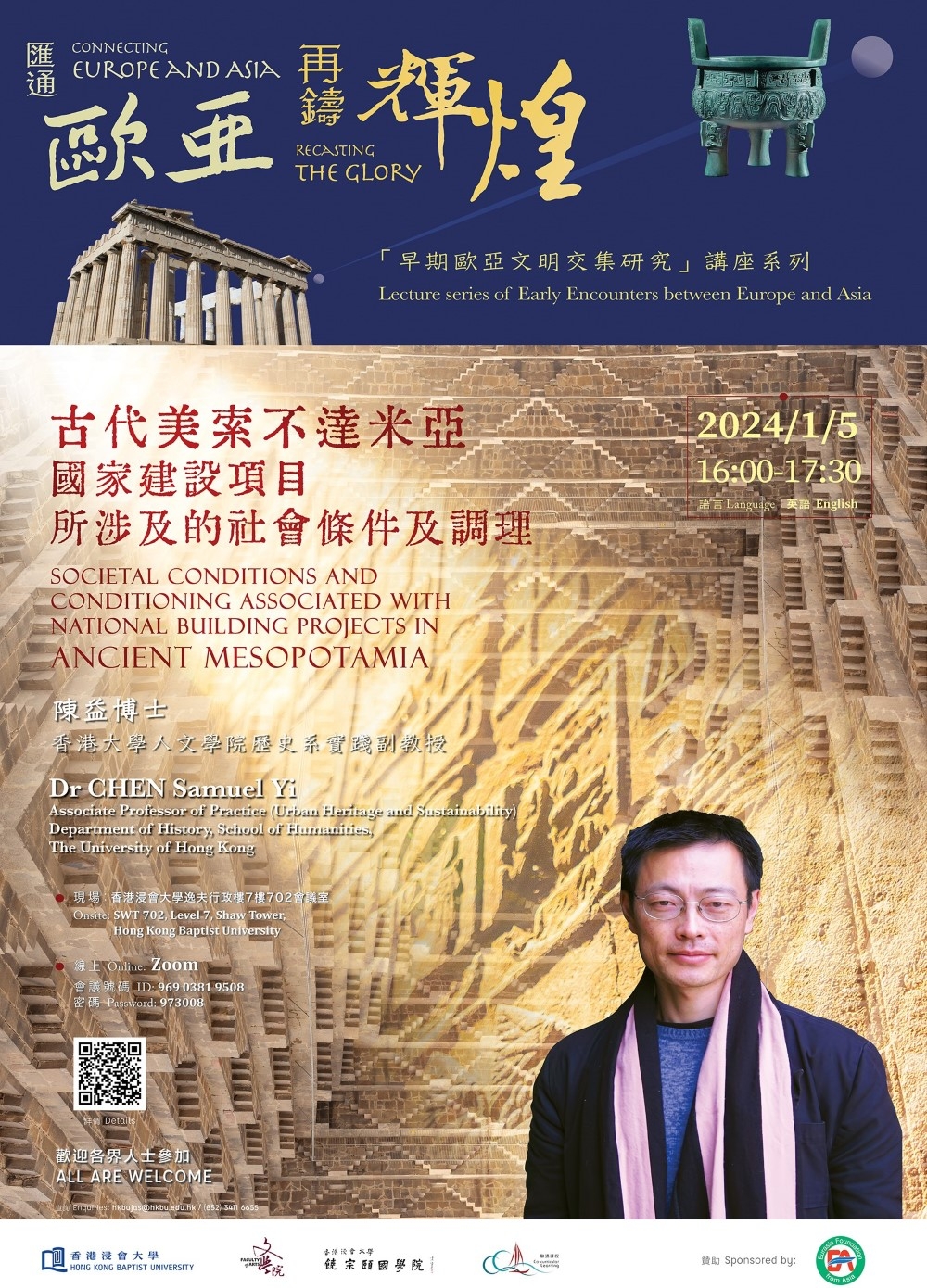
Connecting Europe and Asia, Recasting the Glory: Lecture series of Early Encounters between Europe and Asia
Lecture 13: Societal Conditions and Conditioning Associated with National Building Projects in Ancient Mesopotamia
2024/1/5│16:00–17:30
Dr Samuel Yi CHEN
A Fellow at the Institute for the Humanities and Social Sciences (Faith and Global Engagement) and Associate Professor of Practice (Urban Heritage and Sustainability) at the Department of History, the University of Hong Kong. He received his MA (Harvard) and his PhD (Oxford) in West Asian Languages and Civilisations. He currently researches urban and regional planning and development in relation to state and empire building. In teaching he covers urban and planning history more broadly, from the rise of cities in the fourth millennium BC in ancient West Asia to megacities and megaregions in today’s world. Prior to joining HKU, he conducted research and teaching at the University of Oxford.
- Abstract: Ancient Mesopotamia is widely known for giving rise to some of the earliest and most enduring and influential urban civilisations in the world. This talk seeks to explore the social production of space in ancient Mesopotamia from a historical and historiographic perspective. It examines a long-standing practice of a series of socio-economic governance measures, ranging from controlling market prices, remission of debts and exemption of duties, to social justice and equality, during national building projects in Sumerian, Babylonian and Assyrian cities, as reflected in royal inscriptions, archival documents, and other written sources from the third millennium BC to the first millennium BC. Whilst exploring the functions of these socio-economic measures in service to the building and urban development projects, the study seeks to uncover the broader purposes of these measures beyond the building process. Together with the building and urban development projects, these socio-economic measures and other societal conditions and conditioning (e.g., ritual) practices were intended to create and renew cities and states as exemplary societies with inspiring urban forms and model social organisation and practices. As such, they played a vital role, both ideologically and in practice, for urban and state socio-political and cultural establishment, reform, and transformation. Parallel practices from other parts of the ancient world as well as the modern world will be provided for comparison.
- Language: English
- Summary (Recorded by Zhang Zixuan)
Dr Samuel Yi Chen, Associate Professor of Practice at the Department of History of the School of Humanities of Hong Kong University, delivered a scintillating lecture to us titled: ‘Societal Conditions and Conditioning Associated with National Building Projects in Ancient Mesopotamia.’ As is widely known, the Mesopotamian civilization was, as far as current knowledge extends, one of the earliest in the world. By 4000 BC, the people of the region had already begun using irrigation technology to raise the level of agricultural production and had instigated large-scale communal deployment of human resources, and by approximately 2900 BC, in the basin of the two rivers Tigris and Euphrates, many cities had appeared. At the same time, they also created the earliest and most long-lasting and influential urban civilization. The issue under discussion then is how did Mesopotamia evolve construction and administration of advanced societal space and thereby fashion this resplendent culture so early? Addressing this issue has become a greatly attractive proposition.
The speaker, Dr Chen Yi, has used contemporary excavated documents, for example, inscriptions or archives of the royal house as well as other transmitted historical records, as the foundation of his research. His frames of reference are the numerous norms of modern urban life and economic activity (for example, the relationship of government policy to social equality and justice, or measures taken by city state authorities to control marketplace prices or tax and debt exemption to stimulate the economy). Using the city states or royal dynasties of Babylon, Assyria, and Sumer as case studies, he outlined and expounded the extraordinary experience of urban administration and wisdom of economic practice of our ancestors in these early civilizations of mankind.
As a matter of course, building projects of a national character not only require the physical form of the urban landscape, but they must also be assisted by deities, divination, and ceremonial of religious significance. Similarly, the military security of city states and obtaining sufficient manpower and sources of material were also extremely important. In conclusion, the national construction projects of Mesopotamia embodied clearly defined ideological targets and realized inspirational urban construction and administrative models, and they succeeded in leaving behind a precious physical and spiritual legacy for subsequent generations.
Particularly deserving of mention, Dr Chen Yi referenced the idealized city and society outlined in Plato’s Republic, the humanistic city plans of the European renaissance, and the post-industrialized conception in continental Europe and Britain of the ideal city of the industrial age. He drew attention to similarities and differences between the special nature of Mesopotamian civilization and notions of idealized cities of various epochs, and this was especially valuable.
This lecture series is sponsored by Eurasia Foundation (from Asia).